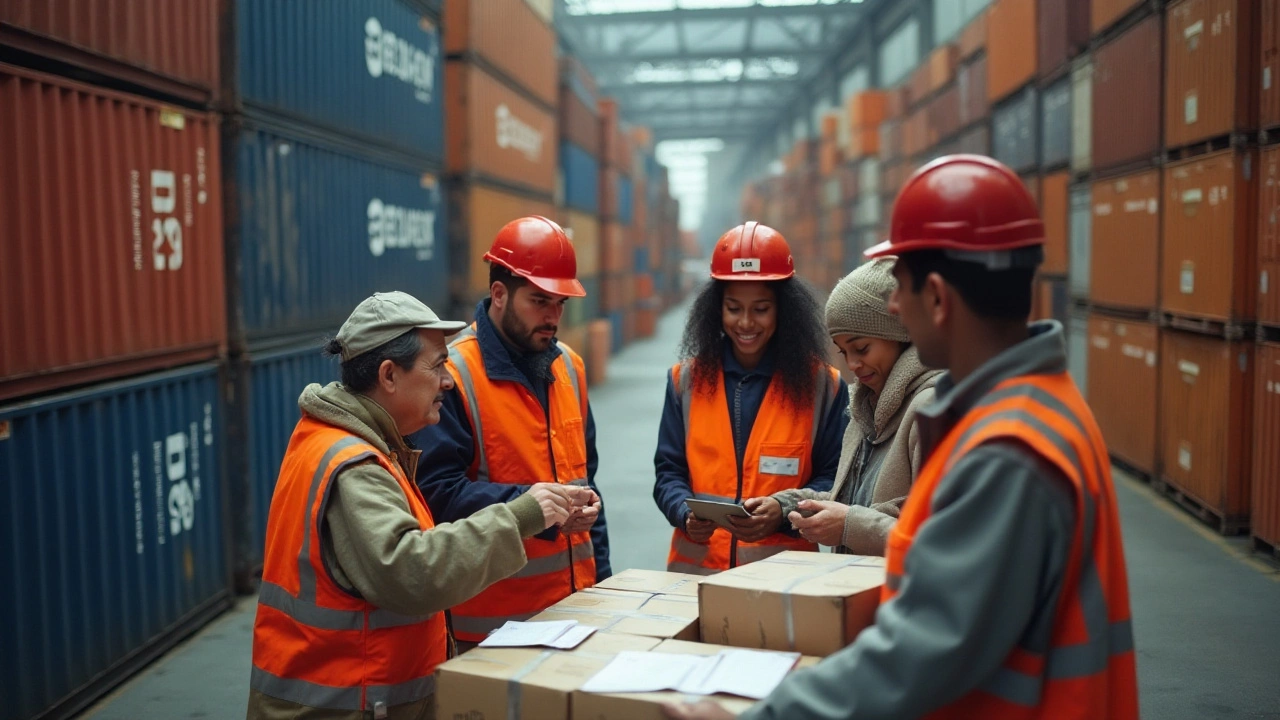Deciding how to ship your goods globally can often feel like navigating a complex labyrinth. One of the most frequent questions that arise is whether it's more economical to use your own boxes rather than relying on pre-packaged options from courier services.
To unravel this, let's start by breaking down the costs associated with international shipping. Diving into the details of how shipping expenses are calculated can uncover opportunities for savings, especially when using personal boxes. While there are clear benefits to choosing your own packaging, such as customizable size and weight considerations, certain pitfalls must also be acknowledged.
In this article, I will discuss everything from the materials you should consider when using your own box to the crucial tips that could potentially save you a substantial amount of money. With every aspect of this decision detailed, you'll feel more equipped to make a cost-effective choice.
- Introduction to International Shipping
- Understanding Shipping Costs
- Benefits of Using Your Own Box
- Materials and Packaging Tips
- Potential Savings and Pitfalls
- Conclusion and Recommendations
Introduction to International Shipping
Navigating the world of international shipping can initially seem overwhelming, conjuring images of vast oceans, complex flight paths, and a tangled web of logistical operations. Shipping goods across borders entails understanding a myriad of regulations, tariffs, and transportation options, each distinct yet interconnected. Adapting to the rise of e-commerce, the industry has seen a sweeping transformation, greatly accelerating in the past decade. The global logistics network now plays a pivotal role in connecting businesses with customers in different corners of the world, fulfilling our relentless demand for products at our fingertips.
The primary consideration when venturing into overseas transport is the intricate cost structure. Shipping costs are influenced by numerous variables, including the size and weight of the parcel—key factors for both economists and casual senders alike. According to the International Chamber of Commerce, shipping costs can make up to 20% of the final retail price, highlighting the importance of strategic planning. Intriguingly, choosing personal or custom packaging might reduce these expenses, depending on how cleverly one manages dimensions and weights.
Each courier service has its unique formulas for calculating shipping fees, often resulting in perplexing disparities. These formulas frequently include base costs that vary by region, surcharges linked to fuel prices, and additional fees contingent on delivery speed. Services like DHL, FedEx, and UPS offer extensive global reach, each with its own nuances. As a New York Times article eloquently states,
"Understanding the true cost of getting a package from point A to point B is the art and science of logistics."Balancing these elements can be daunting, yet essential for cost-effective global commerce.
The second crucial aspect of international transit is the adherence to export and import regulations. Each country harbors its regulations, ranging from prohibited items to prescribed labeling standards that must be rigorously followed. Non-compliance can result in delays or even a complete rejection of goods at customs, hampering the supply chain. Services like FedEx frequently update their shipping guides and provide customer support to assist in navigating these regulatory landscapes, which is indispensable for seamless international transactions.
Understanding the nuances of custom boxes is equally vital. It provides not only a sense of the freedom to shape one’s shipping strategy to optimize costs but also the opportunity to leverage branding in foreign markets. Utilizing your own packaging offers flexibility in parcel dimensions, helping avoid excess fees associated with standard box sizes. It is an evolving craft in the expansive manual of international shipping, a topic that has piqued the interest of novices and seasoned logisticians alike, illustrating a fascinating intersection of commerce, compliance, and creativity.
| Courier | Average Shipping Time | Cost Range |
|---|---|---|
| FedEx | 3-5 business days | $50 - $200+ |
| DHL | 3-7 business days | $40 - $180+ |
| UPS | 4-7 business days | $60 - $220+ |
Understanding Shipping Costs
Recently, there has been a growing curiosity among many of those who engage in international shipping: what's the real breakdown of those fees carriers charge, and how can they be minimized? Understanding these shipping costs can offer a competitive edge, especially if you frequently send parcels abroad. To begin with, the main elements that determine the expense include weight, dimensions, destination, and shipping speed. Notably, the weight of a package isn’t just about how hefty it is; dimensional weight—the package's size—also plays a significant role. Carriers like FedEx and DHL have standardized these measurements; thus, even a lightweight parcel can incur high costs if its size exceeds certain limits.
Another interesting aspect is the shipping zone, which reflects the distance between the origin and destination. Each country has specific zones, and this zoning heavily influences costs. A package sent from New York to Brazil might be more costly than sending one of the same weight to Canada. Additionally, you must calculate fuel surcharges, customs duties, and possible tariffs, which add layers of complexity. Some companies offer software tools to estimate these costs: tools that savvy shippers often exploit to project their expenses more precisely. According to ShippingEasy, "When calculating your shipping costs, paying attention to zones and dimensional weight can save a seller significant sums annually."
Moreover, shipping fees can be influenced by risk factors such as the type, value, and fragility of the items being shipped. For example, sending artwork or electronics might necessitate purchasing additional insurance. These little add-ons quickly multiply and surprise those unprepared with budget overruns. Tracking and handling fees are other hidden charges that, while seeming negligible initially, can accumulate to form a substantial portion of your shipping outlay. To cope with such variable fees, many now focus on packaging tips that allow them to efficiently use smaller boxes, potentially saving costs. Adhering to carrier guidelines and being mindful of such variables is thus an integral responsibility for anyone involved in the business.
Interestingly, some carriers offer small discounts for businesses or individuals who ship frequently and use their packaging. This loyalty can translate into beneficial savings, as packages sent through such programs often bypass certain charges levied on one-time or inefficient shippers. It's also useful to understand that economic and geopolitical dynamics, such as fuel costs and international relations, can lead to adjustments in shipping prices. Finally, comparing carriers is no small feat but proved rewarding; users may find that diversifying their options between UPS, USPS, and other services depends largely on the package and destination specifics. Creating an account with various shipping services can also lead to promotional deals, further offsetting costs.

Benefits of Using Your Own Box
Shipping internationally using your own box may initially seem like just another task on your to-do list, but it can actually be an essential strategy for saving both time and dollars. When you turn to personal packaging solutions, you harness the power of flexibility, which can be an asset when handling various product sizes and weights. This is especially true for small businesses or individuals shipping irregularly shaped or uniquely sized items. By utilizing custom boxes, you can avoid overpaying for large containers when the contents don’t require it, potentially decreasing shipment weight fees.
Let's not forget about the environmental considerations. Using recycled or locally-sourced materials for your packing not only helps cut raw material costs but also resonates with the eco-conscious consumer base. Imagine crafting a brand identity that values sustainability and practicality—it's a win-win! Plus, when shipping internationally, cost implications of weight and size mean more bang for your buck when minimizing packaging. This concept aligns with the more holistic business practices seen globally. According to Eco Friendly Habits, on average, businesses that implement green packaging see a substantial reduction in operational costs due to efficiency improvements.
There's another less talked about benefit—brand appeal and customization. Ever thought about how delightful it might be for customers to recognize your brand from the minute they receive a packaged product? Customizing your packaging allows you to create a unique customer experience from the get-go. Adding your label or a personalized thank-you note inside visibly reinforces customer relationships. Meanwhile, if you are particular about aesthetics or have fragile items, the stronger materials you can utilize in personal packaging can help safeguard against breakages during transit.
Behind these logistics is the science of package engineering, a field where new materials are constantly being tested for increased durability and reduced cost. Industry experts suggest that packaging is not just about the cost of materials, but about right-sizing, which refers to optimizing package dimensions to perfectly suit the product being shipped. Right-sizing helps in minimizing void fill requirements and eliminating unused space, resulting in decreased dimensional weight pricing from carriers. A report from Packaging Digest suggested that 45% of shippers found substantial cost benefits when they switched to personalized boxes that naturally led to standard size adjustments, cutting back on unnecessary filler and oversized boxes.
Additionally, arranging your own packaging gives greater control over securing products, using corner protectors, cushioned paddings, or even double-boxing methods where applicable. If your goods are particularly valuable or fragile, these extra precautions can drastically lower the risk of damage. Knowing the cost savings combined with protection sets a business or individual's mind at ease.
With all of these factors in play, the decision to use your own box goes beyond just cost savings. It's about smart, responsible shipping that benefits the shipper, the receiver, and our planet. In the modern age of brands caring about authenticity and attention to detail, every bit of these advantages creates a significant ripple effect, ensuring longer-term business success and customer loyalty.
Materials and Packaging Tips
The art of preparing your own box for international shipping demands a strategic approach. At the heart of this strategy is choosing the right materials. When selecting the ideal box, consider the composition: corrugated cardboard reigns supreme for its rigidity and lightness. Ignoring this could result in compromising the contents during the arduous journey across seas and through customs clearings. It's equally important to choose a box that snugly fits your items, minimizing excess space to avoid paying for unnecessary weight and reducing the risk of items tumbling within.
Another key material to consider is packing tape. Opt for heavy-duty, durable options to ensure your box remains sealed, steadfast and secure. It's advised to tape across all seams and edges, bolstering against potential breaches that could occur. On top of the tape, a plastic covering or shrink-wrap serves to waterproof the package, an essential precaution when negotiating unpredictable weather conditions. Adding internal cushioning like bubble wrap or packing peanuts is often a distinguishable factor that decides whether an item arrives safely or in shards. For delicate items, using double-boxing, where the primary box is placed inside a larger one with buffer space filled with packing material, provides an additional protective barrier.
Labeling is often overlooked when users prepare packages. Without clear and precise labels, even the most carefully packaged box might get lost. It's crucial to use a waterproof ink and to include both destination and return addresses, marked clearly on multiple sides. USPS recommends placing a copy of the recipient's address and your address inside the box, as well. This ensures that in the unfortunate event that a label is torn or becomes unreadable, your package won't end its journey prematurely. "Label legibility is vital in global logistics," noted the International Shipping Forum in 2022. A detailed label could be a lifeline for any confused depot worker trying to process a battered package.
There’s never a bad time to think of how environmentally friendly your approach to shipping is. Many consumers are now seeking ways to reduce waste, leading to a rise in the popularity of biodegradable and recyclable materials. Numerous brands and courier services now provide eco-friendly packing options that you can use when preparing your own box. If your budget allows, consider investing in these sustainable alternatives, which might even appeal to environmentally-conscious recipients and companies alike.
For those weighing cost against reliability, a gripping stat to bear in mind is this: the International Federation of Freight Forwarders Associations reports that 21% of packages suffer from minor damage primarily due to inadequate packaging choices. You don't want to be part of this statistic; thus, understanding the materials science behind secure packaging can safeguard not just your goods, but your reputation, too. As Jasper, my ever-curious dog, will tell you, sometimes a simple box can contain priceless treasures worth protecting—make sure you wrap them wisely.

Potential Savings and Pitfalls
When contemplating whether to use your own box for international shipping, potential savings are often the biggest allure. Using custom boxes can lead to significant cost reductions on shipping fees. One reason is that carriers, such as FedEx or UPS, often charge based on dimensional weight. This means shippers pay for the space a package occupies, not just its actual weight. By tailoring your packaging to fit snugly around the contents, you can reduce the dimensional weight and save substantially on shipping costs. This flexibility is not just about saving money; it's also a way to ensure that shipped items are less likely to shift and sustain damage during transit, adding an extra layer of security to your package.
On the flip side, there are also pitfalls associated with using custom boxes. One major challenge can be complying with international regulations. Many countries have stringent restrictions and guidelines on what types of packaging materials can be used. For instance, using untreated wood as packing material is prohibited in many regions, due to the risk of pest transmission. If these restrictions are not taken into account, it could result in delays, added costs, or even seizure of goods at customs. Moreover, it's important to ensure the durability of the packaging material. While shaving a few ounces off your package weight can lead to savings, under-packaging can result in damages that cost even more in returns and refunds.
There's also a hidden cost factor related to the labor involved in preparing custom boxes. Using your own packaging means you need to source materials, design boxes to fit your specific items, and ensure that all contents are packed safely. This can be time-consuming and may require a learning curve, especially for items with irregular shapes. Several companies provide their services specifically to help businesses or individuals who frequently need to ship globally, offering packing solutions that comply with international shipping standards. A good example is shipping companies that provide eco-friendly packaging options, which reduce not only cost but also environmental footprint.
"The devil is in the details," notes shipping expert Susan C. Hartley, "and for every penny saved with well-thought-out custom packaging, there’s a potential saving in terms of product integrity and customer satisfaction."
In conclusion, while using personal boxes can introduce a wide spectrum of benefits, from cost-savings to tailored protection, those advantages do come with their own array of challenges. It's important, then, to weigh these factors carefully against your shipping needs. Understanding the fundamentals of international shipping, having a clear view of total shipping costs, including hidden ones like labor, and possibly investing in expert guidance or automated tools that facilitate calculating dimensional weight and material compliance can be crucial in making the best decision.
Conclusion and Recommendations
International shipping presents a multitude of challenges but also offers unique opportunities for saving money, especially when considering the use of personal boxes. From analyzing shipping costs to understanding the nuanced impacts of size and weight on prices, taking the time to discover the optimal shipping solution greatly benefits anyone venturing into international commerce. Notably, the sheer versatility in packaging options allows for enhanced protection of goods tailored to specific requirements, reducing the likelihood of damaged items which can incur further costs.
To embark on this cost-effective journey, consider these critical steps. First, thoroughly understand the specific rules and regulations pertinent to your destination country. Many countries have unexpected restrictions on materials and dimensions. Second, invest in quality packaging materials like sturdy cardboard and reinforced tapes, so that the packaging withstands the rigorous handling involved in shipping processes, potentially minimizing additional fees for damage coverage.
Selecting the Right Courier
Choosing an appropriate courier service aligns closely with your shipping needs. Seek out courier services that offer flat rate boxes, especially if your own packaging solution doesn’t meet their standard dimensions. This simple adjustment might yield significant cost savings. Recently, a study indicated that boxes not conforming to standard expectations were more likely labeled as oversized, incurring additional charges.“The key to minimizing shipping costs lies in both intelligent packaging selection and an in-depth study of courier pricing structures,” says logistics expert John Carver.
One should also be mindful of volume: sending a few larger shipments might end up being cheaper than frequent smaller deliveries due to economies of scale. A well-implemented shipping strategy brings not only monetary savings but can immensely improve your overall shipping efficiency and speed.
These insights should embolden anyone looking to streamline their overseas shipments. Delve deeper into international shipping specifics, adapt to learning and changing marketplace trends, and perhaps even simplify your processes by limiting the variety of box sizes, contributing to reduced costs. Using these strategies will enable you to ship smarter, not harder, saving you money and time in an ever-evolving and complex industry of international shipping.


